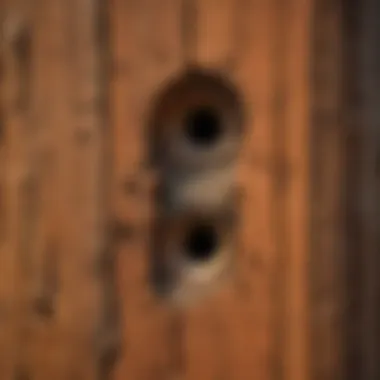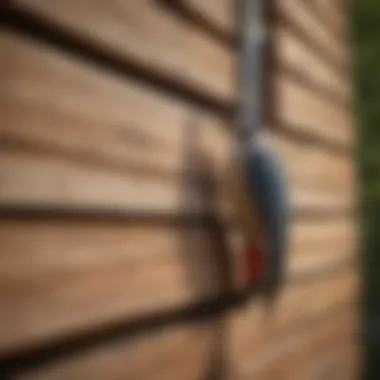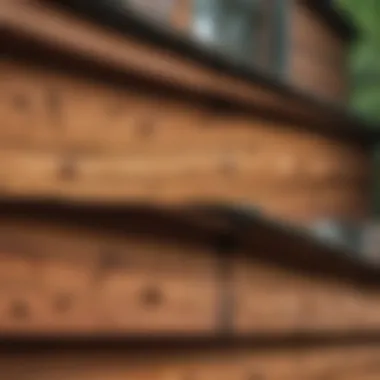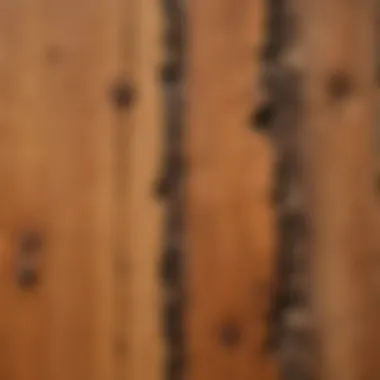Repairing Woodpecker Damage to Cedar Siding


Intro
Woodpeckers, while often seen as charming birds, can present significant challenges when it comes to the maintenance of cedar siding. These creatures might cause holes that affect not just the appearance but also the structural integrity of the siding. Understanding the behavior of woodpeckers and the implications of their activity can help homeowners mitigate damage effectively. The process of assessing the extent of the damage and applying effective repair techniques is essential. This article serves as a comprehensive guide to addressing woodpecker holes in cedar siding, ensuring that property owners can maintain both the aesthetics and integrity of their homes.
Overview of Woodpecker Behavior
Woodpeckers are driven by a few key behaviors such as searching for food, creating nesting sites, or marking territory. These behaviors can lead to serious damage if they occur on your home.
Why Woodpeckers Choose Cedar Siding
Cedar siding is favored by woodpeckers for several reasons:
- Food Sources: Insects often infest cedar, attracting woodpeckers.
- Sound Resonance: Cedar has favorable acoustic properties that woodpeckers like when drilling.
- Nesting Material: The softwood is easier for woodpeckers to boring into than harder options.
Understanding these factors can help in assessing the primary motives behind woodpecker intrusion and can lead to more effective preventive measures.
Assessing the Damage
Determining the extent of the damage is crucial. This involves closely examining the cedar siding for holes, cracks, and other signs of wildlife activity.
Steps for Assessment
- Visual Inspection: Look for any drilled holes or scuffed regions.
- Identify Active Nesting: Listen for pecking or chirping sounds.
- Check for Insects: Look for trails left by wood-boring insects.
- Consider the Area: Examine if the damage is localized or widespread.
A thorough assessment can guide what repair methods are necessary.
Repair Techniques
Once the damage has been assessed, homeowners need to consider their repair options. Successfully fixing woodpecker holes requires knowledge of both repair techniques and available materials.
Recommended Repair Methods
- Filling Holes: Use wood filler or epoxy to patch smaller holes. This can restore the integrity of the siding.
- Replacing Boards: For larger or multiple severe damage areas, replacing the affected boards may be necessary.
- Surface Treatments: Applying specific coatings can deter further woodpecker activity.
Each approach addresses different levels of damage, making it important to choose the right method based on the severity of the issue.
An effective repair strategy begins with a clear understanding of woodpecker behavior and the assessment of the damage. The right approach not only resolves the current issue but also helps to prevent future occurrences.
End
Addressing woodpecker holes in cedar siding requires both understanding the underlying causes and implementing effective repair strategies. Homeowners are better equipped to handle these situations when they are informed and prepared. A sustainable approach to repairing woodpecker damage ensures long-term protection against both aesthetic and structural issues.
Understanding Woodpecker Behavior
Understanding the behavior of woodpeckers is crucial for homeowners dealing with cedar siding. This knowledge contributes to effective management and prevention strategies. Addressing the activity of these birds goes beyond simply recognizing their presence; it involves comprehending their reasons for drilling into wood. By knowing what attracts them, one can better protect their property from future damage.
Species of Woodpeckers
There are various species of woodpeckers, each with specific habits and preferences. Some common species include the Downy Woodpecker, Northern Flicker, and Red-bellied Woodpecker. Each species displays unique behaviors that affect how they interact with cedar siding. For example, Downy Woodpeckers are typically smaller and less destructive compared to their larger relatives, like the Pileated Woodpecker, which can cause significant damage. Understanding these distinctions helps homeowners anticipate potential threats based on the woodpecker species prevalent in their area.
Reasons for Drilling
Woodpeckers drill into wood for various reasons, and understanding these motives can help mitigate damage. Three main reasons include:
Finding Food
Finding food is a primary driver for woodpecker drilling. These birds mainly seek out insects hidden beneath the bark of trees and wooden structures. This behavior directly impacts cedar siding, as woodpeckers can cause holes while searching for their meal. A key characteristic of this motive is the persistence of woodpeckers in their quest for food. They often return to the same spot until they extract the insects, exacerbating the damage to your siding. The advantage here is that knowing they are after food can inform how to make the siding less appealing, perhaps through targeted pesticide applications.
Establishing Territory
Another reason for drilling is the establishment of territory. Male woodpeckers will drum on trees and surfaces to assert dominance over their area. This often leads them to cedar siding, as it offers a resonance that carries their drumming signals over long distances. This behavior is significant because it marks the woodpecker's presence. It can lead to sustained noise and more invasive drilling if not addressed. However, understanding this aspect can guide homeowners in identifying the breeding seasons and implementing timely preventive measures.
Nesting Habits


Woodpeckers also drill for nesting. They create cavities in softwood, like cedar, for their young. This nesting behavior is particularly concerning because it not only damages the siding but can also lead to more extensive structural issues. Woodpeckers tend to return to the same nesting sites year after year. Recognizing this can help in planning strategies to deter them before they establish a nest. While this behavior poses challenges, it also emphasizes the importance of understanding the full cycle of woodpecker activity.
Understanding the reasons behind woodpecker activity enables homeowners to proactively address potential issues with their cedar siding.
At each stage, from food searching to establishing territory and nesting, there are opportunities for intervention. By combining knowledge of species and behavior, homeowners can effectively minimize damage and maintain the integrity of their cedar siding.
Identifying Damage on Cedar Siding
Identifying damage on cedar siding is crucial for addressing the problems caused by woodpecker activity. The early detection of issues is vital as it helps prevent further structural damage and preserves the aesthetic quality of the home. Aside from aesthetic drawbacks, unnoticed damage can lead to significant concerns over time, including water infiltration and the potential spread of rot. Thus, careful examination of the cedar siding can save homeowners from extensive repair costs and unnecessary hassle in the future.
Visual Inspection Techniques
Visual inspection is the first step in assessing the condition of cedar siding. Homeowners should look for any visible signs of damage, such as holes, cracks, or irregularities in the wood surface. A systematic approach includes checking different sections of the siding, especially areas with signs of woodpecker activity. It is advisable to inspect from a distance and then move closer to examine specific spots more thoroughly.
During your inspection, pay attention to:
- Holes: Size and depth of the holes can indicate how severe the issue is.
- Fractures: Any splits or cracks can suggest weakening of the wood structure.
- Surface Texture: Changes in texture may indicate rotting or other forms of degradation.
Assessing the Extent of Damage
Assessing the extent of damage is essential for determining the best course of action for repairs. Knowing whether the damage is superficial or involves the structure of the wood will guide the repair process. This involves a closer look at each hole as well as any associated damage.
Shallow Drilling vs. Structural Damage
When evaluating the damage, it is important to understand the difference between shallow drilling and structural damage.
- Shallow Drilling: This type of damage often affects only the surface of the wood. Holes that penetrate a few millimeters deep can typically be filled easily with wood filler. This is a beneficial choice because it simplifies repairs and can be done by homeowners without professional assistance.
- Structural Damage: If the drilling extends deeper, compromising not just the outer layer but the internal structure, this becomes more problematic. Structural damage can weaken the siding and expose it to further environmental issues, making it a critical point of assessment. Repairing structural damage may require professional help and could involve replacing sections of siding, which can be costly.
Signs of Wood Decay
Identifying signs of wood decay is equally important. Wood decay can occur due to constant exposure to moisture combined with woodpecker holes. Key signs to look out for include:
- Soft Spots: Any areas that feel spongy or soft to touch may indicate underlying rot.
- Discoloration: Dark or discolored patches may signal decay, requiring timely intervention.
- Mold Growth: Presence of mold or mildew is a red flag and suggests that moisture is present, furthering decay and damage.
The advantage of recognizing signs of wood decay is that timely repairs can prevent spreading damage and protect the overall integrity of the structure. Homeowners who monitor these aspects are more likely to maintain their cedar siding’s beauty and functionality well into the future.
"Early detection of wood damage leads to cost-effective solutions. Ignoring these signs can result in major repairs down the line."
The ability to identify and assess the extent of damage on cedar siding allows homeowners to take swift action, ensuring the longevity and appearance of their property.
Preparation for Repairs
Gathering Necessary Tools and Materials
Putty Knives
Putty knives are essential for the repair process. They are used for applying wood filler smoothly into the holes left by woodpeckers. A high-quality putty knife is typically made of stainless steel which offers flexibility and durability. It should also have a comfortable handle for ease of use.
The unique feature of a putty knife is its flat blade which allows for even application and leveling of filler. This characteristic is invaluable when aiming to restore the surface of the cedar siding to its original state. The downside is that without proper handling, there can be some scratches on the wood that may need further touch-ups afterward.
Wood Filler
Wood filler is another key component in this repair process. It serves to fill the holes and restore a seamless appearance to the siding. A good wood filler will be durable, easy to work with, and compliant with the color of the cedar. Selecting a wood filler that matches the wood grain closely is essential for achieving a satisfactory finish.
The unique quality of wood filler lies in its ability to harden and bond with the wood, ensuring long-lasting repairs. On the downside, some fillers may expand or crack over time, particularly in regions with fluctuating temperatures. Choosing the right product is important.
Paint or Stain
After repairing the holes, it is often necessary to apply paint or stain. This not only enhances the appearance of the siding but also provides further protection against environmental factors. Opting for a paint or stain that is designed for outdoor use ensures better durability. A key characteristic to look for is UV resistance, which helps prevent fading over time.
The unique aspect of using paint or stain is the ability to fully match the existing wood tone while ensuring the repair blends seamlessly into the overall structure. However, applying paint might require additional preparation of the surface, such as sanding, which can prolong the repair process.
Safety Precautions
Alongside gathering tools and materials, safety precautions cannot be overlooked. Using protective gear like gloves, goggles, and masks ensures that the repair process is conducted safely. It is critical to handle sharp tools such as the putty knives carefully, and be mindful of any falling debris or dust from the surrounding area.


Before beginning repairs, ensure you have all necessary tools and materials at hand. Proper preparation can significantly enhance repair quality and minimize future issues.
Maintaining a safe work environment cannot be understated. Being prepared means being cautious and aware of potential hazards during repairs.
Repairing Woodpecker Holes
Repairing woodpecker holes in cedar siding is a pivotal task for homeowners. These repairs not only enhance appearance but also ensure structural integrity. Addressing this type of damage promptly prevents further deterioration. Knowing how to repair these holes can save time and money, avoiding costly future repairs. Homeowners become well-equipped to tackle these challenges, promoting sustainable practices while maintaining their properties.
Cleaning the Area
Cleaning the area around woodpecker holes is the first essential step. This process involves removing loose debris and any damaged wood. It is crucial to ensure the surface is clear before applying any filler. Use a putty knife to scrape away any splintered wood and dust. A clean surface allows for better adhesion of wood filler. Ensuring a tidy area also helps in assessing the full extent of the damage caused by woodpeckers.
Applying Wood Filler
Once the area is cleaned, the next phase is applying wood filler. This filler serves to restore the wood's shape and integrity. Select a wood filler that is suitable for external conditions, especially designed to withstand weather elements. Apply the filler using a putty knife, pressing it into the hole firmly. Smooth the surface for a seamless finish. Let the filler dry completely, following the manufacturer’s instructions. Proper application can significantly extend the life of siding and improve aesthetics.
Finishing Touches
After the wood filler has dried, it’s time for the finishing touches. This includes either painting or staining the area to match the existing siding.
Painting vs. Staining
Choosing between painting and staining is significant. Painting provides a solid, color-rich finish, which can effectively conceal repairs. However, paint may peel over time, requiring frequent maintenance. Staining, on the other hand, enhances the natural grain of cedar, adding warmth to the wood. It penetrates deeply for longer-lasting results, but may offer less color variety. In this article, we prefer stains for cedar, as they maintain the wood’s beauty while protecting it effectively.
Matching the Cedar Texture
Matching the cedar texture is another critical consideration. Achieving the proper texture enhances the visual appeal and continuity of the siding. Using sandpaper after applying filler can help replicate the original appearance. This unique feature distinguishes the repair, making it less noticeable. A seamless texture prevents potential water trapping, reducing future problems. Thus, textural matching is a beneficial practice when repairing woodpecker damage, ensuring consistency and longevity.
Preventing Future Infestations
Recognizing the importance of preventing future woodpecker infestations is a critical aspect of maintaining cedar siding. Once woodpeckers have drilled into the siding, the damage can become more extensive over time if not addressed. The consequences include not just aesthetic concerns but also potential risks to structural integrity. By implementing effective prevention methods, homeowners can mitigate future damage, thus reducing repair costs and maintaining property value.
Woodpecker Deterrents
Visual Scare Tactics
Visual scare tactics play a significant role in preventing woodpeckers from revisiting already damaged areas. The key characteristic of this method lies in its use of reflective surfaces or movement to dissuade birds. Items such as aluminum foil strips, plastic owls, and shiny objects can create an unsettling environment for woodpeckers. This method is beneficial because it is low-cost and easy to implement.
However, a unique feature of visual scare tactics is that their effectiveness may diminish over time as birds become accustomed to the same deterrents. Therefore, homeowners should periodically change or rotate their scare devices to maintain the effectiveness.
Sound Devices
Sound devices provide another layer of prevention against woodpecker activity. These devices emit annoying or predator-like sounds to scare away woodpeckers. The key characteristic of sound devices is their ability to cover a larger area compared to visual tactics. They are popular among homeowners looking for a more hands-off solution.
The unique feature of sound devices is their potential to disrupt other wildlife, which could be seen as a disadvantage. Care must be taken to avoid disturbing other birds or pets. Additionally, sound devices require power sources or batteries, adding to ongoing maintenance considerations.
Regular Maintenance Tips
Siding Inspections
Regular siding inspections are essential for identifying early signs of woodpecker activity. A systematic approach to inspecting the siding ensures any damage is noticed before it escalates. The key characteristic is that these inspections can often be performed quickly and conveniently, making them a beneficial practice for all homeowners.
A unique feature of siding inspections is that they allow homeowners to check for not only woodpecker damage but also other issues like water damage or rot. Early detection of such problems can save considerable time and money in repairs.
Repairing Weather Damage
Repairing weather damage is directly tied to preventing woodpecker infestations. If the siding is compromised due to weather, it becomes more attractive to woodpeckers seeking nesting or feeding opportunities. The key characteristic of repairing weather damage is that it reinforces the siding, making it less vulnerable. This method is beneficial because it also enhances the overall appearance and longevity of the siding.
The unique feature here is that timely repairs can significantly reduce the chances of attracting woodpeckers. However, maintaining regular repair schedules can be seen as a disadvantage for some homeowners, as this requires diligence and some upfront investment.
If you invest in prevention now, you can save yourself from larger expenses later.
Environmental Considerations


Environmental considerations play a crucial role in understanding and addressing woodpecker damage to cedar siding. These factors ensure that repairs do not just resolve the issue, but are also done in a manner that respects the surrounding ecosystem and promotes sustainability.
Notably, employing sustainable repair practices helps reduce waste and minimizes the impact of human activity on the environment. By utilizing eco-friendly materials and methods, homeowners can effectively address woodpecker holes while supporting broader environmental initiatives.
Furthermore, integrating these considerations into the repair process assists in nurturing a balanced coexistence with wildlife. Recognizing woodpeckers as part of the local biome encourages responsible repair and wildlife management practices. This approach not only addresses existing damage but also aims to prevent future occurrences by creating an environment that respects natural habitats.
Sustainable Repair Practices
Sustainable repair practices involve several methods that prioritize environmental preservation. These strategies can include:
- Using Eco-Friendly Materials: Choose wood fillers and paints that are low in volatile organic compounds (VOCs) to reduce harmful emissions.
- Minimizing Waste: When repairing, aim to use leftover materials from previous projects instead of purchasing new ones. This reduces the overall resource consumption.
- Recycling Reclaimed Wood: If re-siding or repairing requires wood materials, consider using reclaimed wood from local sources to lessen the demand on new timber resources.
Implementing these practices not only helps in fixing the cedar siding but also showcases a commitment to environmental stewardship.
Understanding Local Ecosystems
Understanding local ecosystems is essential in the context of repairing cedar siding damaged by woodpeckers. Each region has its own unique wildlife, and knowing the specific woodpecker species and their behaviors can inform the repair process. For example, some woodpecker species are more migratory than others, which may influence their drilling habits and thus, the timing of necessary repairs.
It is also vital to recognize the interconnectedness of wildlife and their habitats. Here are some insights on this interrelationship:
- Ecosystem Balance: Woodpeckers play a role in the ecosystem by controlling insect populations and creating nesting sites for other species.
- Habitat Protection: Understanding the habitat Tthat these birds prefer can help in placing appropriate deterrents without damaging their necessary living conditions.
- Long-Term Care: Adopting a broader perspective will lead homeowners to care for the whole environment, ensuring that repairs do not disrupt local wildlife.
Equipped with this knowledge, homeowners can make informed decisions that integrate successful repair techniques with a respectful approach to the natural world.
Engaging with Wildlife Experts
Engaging with experts in wildlife is crucial when dealing with woodpecker issues. These experts have the knowledge to assess not just the damage done but also the behavior of woodpeckers. Understanding their habits can be helpful in finding long-term solutions. Relying on professionals can alleviate concerns for homeowners. They may point out signs of recurring problems or potential threats that could arise in the future.
Consulting with wildlife experts ensures that repairs are made not only to fix existing problems but also to prevent new ones. They provide insights into local species, their nesting seasons, and the best strategies to deter them. This information makes it easier to manage repairs and any ongoing prevention work. Taking the time to engage with these professionals saves homeowners from repeating costly mistakes.
Additionally, wildlife experts help balance home maintenance with environmental responsibility. They can encourage methods that foster coexistence with nature rather than exclusion or harm.
When to Consult a Professional
Knowing when to involve a professional can save time and resources. If the damage from the woodpeckers is extensive, multiple holes are present, or underlying structural issues arise, a consultation is warranted. Experts can assess potential risks and provide practical solutions tailored to the specific conditions of the siding.
Homeowners should also consider reaching out when they are unsure about identifying the type of woodpecker causing the damage. Differentiating between species can influence the repair approach and prevention strategies.
Regular assessments, particularly before nesting seasons, could also necessitate expert input. By catching potential problems early, solutions can be implemented effectively.
Resources for Homeowners
Homeowners seeking guidance can benefit from specialized resources. Two valuable categories include local wildlife agencies and conservation organizations.
Local Wildlife Agencies
Local wildlife agencies play an essential role in aiding residents with wildlife concerns. These agencies often provide free consultations, expert advice, and educational programs focused on coexisting with local wildlife. Their primary characteristic is their familiarity with the local ecosystem and specific woodpecker species.
One notable advantage of engaging with local wildlife agencies is their regulatory knowledge. They can inform homeowners of local laws regarding wildlife protection and recommend solutions that comply with regulations. However, their resources may vary by location, impacting the level of support available.
Conservation Organizations
Conservation organizations promote the preservation of habitats and species while also offering resources for homeowners. These groups are valuable for their focus on sustainable practices and education regarding wildlife behavior. Their key characteristic lies in their commitment to research and ecological balance.
Engaging with conservation organizations can provide homeowners with unique insights into more complex issues involving woodpeckers. They may also offer workshops and resources that educate the public about humane deterrent measures. Though they may not provide direct repair services, their educational role is vital in developing informed approaches to wildlife issues.
By connecting with professionals, homeowners can adopt expert knowledge, ensuring responsible management of woodpecker interactions, benefiting both properties and local wildlife.
The End
Understanding how to effectively repair woodpecker holes in cedar siding is essential for homeowners aiming to protect their property. This article emphasizes the necessity of addressing woodpecker damage promptly, as neglect can lead to more severe structural issues.
When reviewing the methods detailed in this guide, several critical aspects come to light:
- Identification of Damage: Recognizing the specific signs and assessing the depth of damage can significantly influence the repair strategy. This approach minimizes future complications.
- Methodical Repairs: Utilizing the appropriate tools and techniques ensures that repairs are both effective and visually appealing. Applying wood fillers correctly and finishing surfaces with matching paint or stain preserves the integrity of the siding.
- Preventive Measures: Engaging with visual and auditory deterrents can mitigate future infestations. Homeowners should develop an ongoing maintenance routine that includes regular inspections of the exterior conditions of their homes.
In essence, this section of the article encapsulates how a proactive and informed stance towards woodpecker holes can sustain the aesthetic and structural quality of cedar siding. As trees, insects, and external elements interact within local ecosystems, understanding these dynamics becomes paramount for sustainable home maintenance.
"Awareness and action create a robust defense against the challenges presented by local wildlife."
By integrating knowledge of woodpecker behavior, damage recognition, and repair processes, homeowners not only uphold the beauty of their properties but also contribute to responsible environmental stewardship. This multifaceted approach reinforces the bond between living structures and their natural surroundings.







